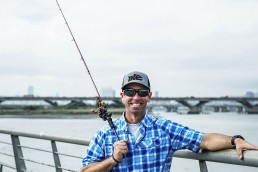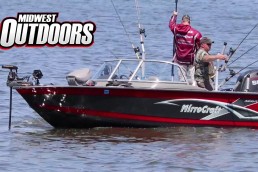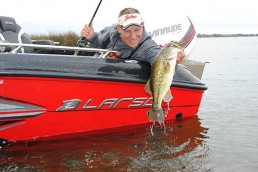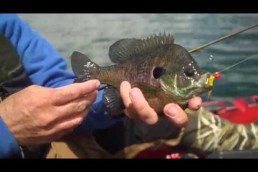Fishing for New Anglers
SHARE THIS POST
We’re all about finding fishing adventure where you live––which, for millions of Midwesterners, means in and around the fringes of cityscapes.
There is a movement afoot that’s drawing people outdoors, where they discover life-enhancing benefits of time spent in fields, woods, and waters. Many have never fished, but might like to, if they knew how to get started. Perhaps they need a role model, somebody who really knows how to fish and is comfortable sharing the shoreline with skateboarders and taxicabs.
Mike Iaconelli, or ‘Ike,’ as most know him, is such a role model. He is hosting a new television show, Fish My City with Mike Iaconelli. In it, you’ll see how he finds places to fish, discover local characters at each stop, and gain perspective on the places inner-city fish live.
We encourage you to watch Fish My City which debuted on Nat Geo WILD October 12. To get you ready, we caught up with Ike for an exclusive sit-down about the new show.
MidWest Outdoors: We introduced your new show last month. But let’s talk more about the details. For starters, this show is very much like the first show you did, right?
Mike Iaconelli: This is my third show, and you are right in that it’s kind of a rebirth of my first show, City Limits Fishing. All about fishing adventures you can find inside the city limits. In between, I did one called Going Ike, which is still running. That one has changed into more of a project that we air on our YouTube Channel (bit.ly/GoingIke). You’re still going to see a lot of unique Going Ike content go up every week. But, man, this opportunity (Nat Geo show) is just unbelievable. It gets us back to that premise of fishing in urban settings. And my wife Becky and I feel that it’s a great platform to reach new people.
MWO: Tell us more about how the show came to be.
Ike: It’s been a dream come true for us. Nat Geo was looking for new fishing programming. They saw one of my Going Ike shows, which we shot in Central Park in New York City. They liked the premise, we got on a phone conference, and I gave them my history and background. After that, we shot a pilot in Washington, D.C., on the upper Potomac River, on the tidal Potomac. They loved how the pilot came out and how it’s more than just a fishing show. Each of these are stories of an adventure to these different cities.
I love that. I love going to London and capturing the story of how we are going after three species of fish to check them off my bucket list. This was really important to me, because I wanted it to be real, and have us going after a real goal. It was not only real but it was tough, because we only had four or five days, in most cases, to catch those three species and show a lot of other things about the city.
When we were in Miami, we doubled up, because I made a list of three freshwater and three saltwater species to catch. So we had to catch six species in five days. It was a real challenge and turns out to be a real learning experience for me. Really, the whole experience has been a learning process. That’s what’s going to be really fun, because the viewers are going to be able to learn along with me.
Are you enjoying this post?
You can be among the first to get the latest info on where to go, what to use and how to use it!
MWO: With the locations you filmed for this first season (Miami, New York City, New Orleans, Austin, London, and Taipei), we’re going to see great scenery, meet interesting characters, and learn with you as you fish the target species. It does sound like a recipe for reaching people who might not fish now, but could become hooked.
Ike: We think so, too; the other thing that’s great is that it’s Nat Geo, right? It was important for them to make this more about the story, about the fish and the city, not just the fishing. So the hard-core anglers, fish-heads, you’re gonna get your fish catching, techniques, strategy, baits, and rigging. But you’re also gonna get a lot of information about the city. The history of the city, the culture, the people, the food, the culinary specialities of each location.
And I think viewers who are not anglers will be drawn into the quest for catching the bucket-list fish. That process is the same whether it’s a 12-inch trout in a stream or a 300-pound tuna out in the ocean. A bucket-list fish doesn’t have to be big, though it can be. I think people will appreciate that and enjoy watching the process we go through to catch each one.
MWO: How did you choose the cities for the first season?
Ike: We started off with a list, developed by the production team and me, and it was like 24 places we’d like to film. We whittled the 24 down to 12, then down to the final 6 we chose. The first season is so important, because you want to include everybody but of course you can’t. We chose two international cities and four American cities. The show is airing in 148 countries, so we thought that was a good mix of locations. I hope this series runs for 15 years because there are a lot of cities in the States that I want to fish.
We’re also excited because Nat Geo is a channel that people turn on and let it run, kind of like Discovery and that type of channel. So we’ll reach people that heretofore have probably not been exposed to much fishing, and that’s fantastic.
For more information…
For details on ‘Fish My City with
Mike Iaconelli’ on Nat Geo WILD:
MWO
SHARE THIS POST
Did you enjoy this post?
You can be among the first to get the latest info on where to go, what to use and how to use it!



